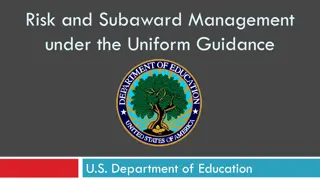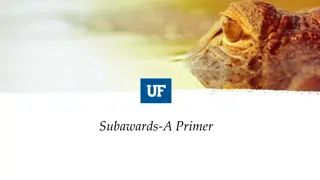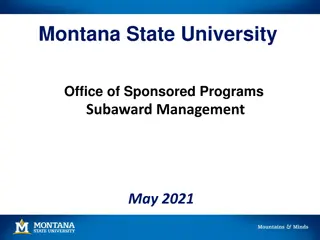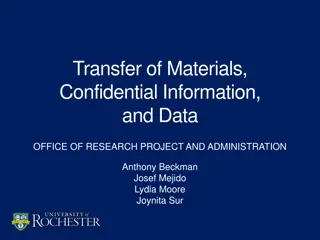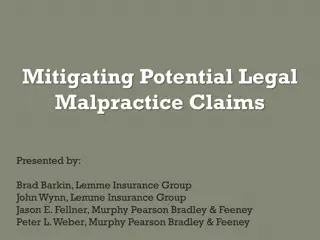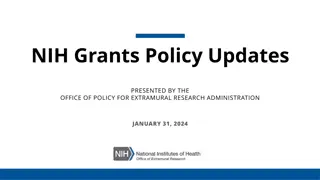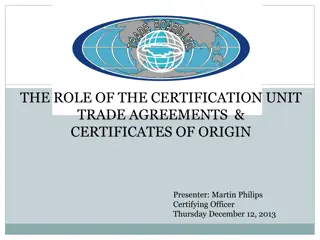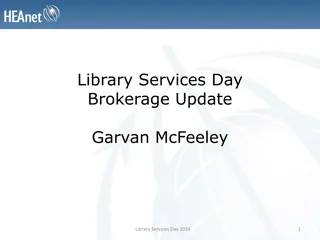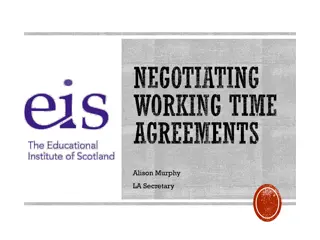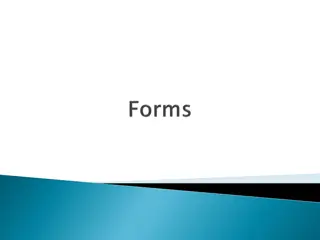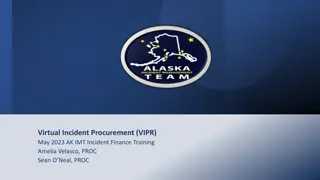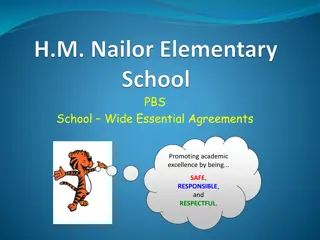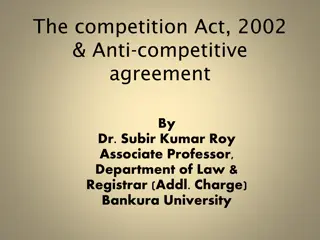Key requirements and case studies of Subaward Agreements
Learn about the key requirements and case studies of subaward agreements in NIH grants, including the role of the prime recipient, setting up the agreement, written agreement elements, and invoicing and reimbursement. Gain insights from experts in the field.
- subaward agreements
- NIH grants
- prime recipient
- written agreement
- key elements
- case studies
- requirements
- invoicing
- reimbursement
Download Presentation

Please find below an Image/Link to download the presentation.
The content on the website is provided AS IS for your information and personal use only. It may not be sold, licensed, or shared on other websites without obtaining consent from the author. Download presentation by click this link. If you encounter any issues during the download, it is possible that the publisher has removed the file from their server.
E N D
Presentation Transcript
Subaward Agreements Key Requirements and Case Studies| November 9, 2022
NIH PRESENTATION TEAM MODERATOR PRESENTERS KASIMA GARST, M.F.S. Systems Policy Analyst Office of Policy for Extramural Research Administration (OPERA) Office of Extramural Research (OER), NIH MICHELLE G. BULLS Director, Office of Policy for Extramural Research Administration (OPERA) Office of Extramural Research (OER), NIH EMILY LINDE KRISTIN TA Director, Grants Management Program National Institute of Allergy and Infectious Diseases (NIAID), NIH Senior Advisor Office of Policy for Extramural Research Administration (OPERA) Office of Extramural Research (OER), NIH
What is the Role of the Prime vs. Sub The primary recipient of NIH grant funds is accountable to NIH for: the performance of the project the appropriate expenditure of grant funds by all parties applicable reporting requirements all other obligations of the recipient as outlined in the NIHGPS The prime recipient must perform a substantive role must perform a substantive role in the conduct of the planned research and not merely serve as a conduit of funds to another party or parties. This includes being able to provide appropriate oversight of all scientific, programmatic, financial, and administrative matters related to the grant. Terms and conditions flow down to the subrecipient. 3
Setting up your Subaward Agreement Must be done in partnership between the prime and subrecipient. The recipient must enter into a formal written agreement formal written agreement with each consortium participant, which must address all required elements. Agreement must address the negotiated arrangements for meeting the scientific scientific, administrative administrative, financial financial, and reporting grant, including those necessary to ensure compliance with all applicable Federal regulations and policies and facilitate an efficient collaborative venture. The agreement must be approved by the AOR at both institutions. When there a questions/concerns contact the funding IC for support reporting requirements of the 4
Written Agreement Key Elements NIH GPS 15.2.1 Provides the detailed requirements for consortium agreements. Identification of the individual who will serve as the consortium lead investigator. Procedures for directing and monitoring the research effort. Procedures to be followed in reimbursing each consortium participant for its effort. A determination of policies to be followed in such areas as travel reimbursement and salaries and fringe benefits 5
Written Agreement Key Elements (Cont.) Terms that establish whether the Financial Conflict of Interest policy of the awardee Institution or that of the subrecipient will apply to the subrecipient s Investigators. A provision addressing ownership and disposition of data produced under the consortium agreement A provision making the NIH data sharing and inventions and patent policy applicable, including a requirement to report inventions to the recipient. Expectations for authorship and co-authorship on publications and provisions regarding property (other than intellectual property), program income, publications, reporting, and audit necessary for the recipient to fulfill its obligations to NIH. Incorporation of applicable public policy requirements and provisions. 6
TEST YOUR KNOWLEDGE!
Procedures for Directing and Monitoring the Research Which of the statements below is the best example of appropriate agreement language? A) Subcontractor A agrees to report progress to Prime Recipient B. Prime Recipient B will review the work performed and may conduct site visits, as appropriate. B) Subcontractor A will submit quarterly progress reports to Prime Recipient B, and will provide all relevant supporting documentation, upon request. Prime recipient B will review the quarterly reports and provide feedback on work performed. Prime Recipient B may conduct site visits to assess progress, as needed. 8
Answer: B It is important to include details in subaward agreements, such as the timing of report submission and the requirement that the subrecipient provide supporting documentation. Maintenance of supporting documentation and providing it upon request is a requirement (45 CFR Part 75.364) that flows down to the subrecipient. If issues arise, a well-written subaward agreement is critical to resolve any compliance concerns. If the prime doesn t include the appropriate requirements in the written agreement, THEY are the ones responsible to NIH.
Invoicing and Reimbursement Which of the elements below should be outlined in a subaward agreement? (select all that apply) A) Schedule and method of reimbursement B) Statement of work and schedule for any required deliverables C) Policies for travel reimbursement and salary and fringe benefit costs D) Requirements for providing any supporting documentation 10
Answer: All of the above! Laying out the timing and documentation requirements for invoicing up front is critical to the success of a subaward agreement and is required per NIH GPS 15.2.1. Set expectations up front for how frequently invoices will be submitted and payment provided. For prime recipients, it s important to consider NIH reporting requirements in this timeline. For example, final invoices from subrecipients must be received timely at the end of the project, so that recipients can complete all closeout reports within 120 days (see NIH GPS 8.6). It s also important to outline policies for costs like travel reimbursements and salary and fringe benefits up front to minimize any challenges or confusing when invoices are submitted. Specify whether the subrecipient will follow the prime s policies or their own. Subrecipients may use their own policies, as long as they meet all relevant NIH requirements (see NIH GPS 15.2.1) Remember Remember the NIH requirements flow from the prime to the sub, and that needs to be clearly captured in the the NIH requirements flow from the prime to the sub, and that needs to be clearly captured in the subaward agreement! subaward agreement!
Prior Approval When a subrecipient needs prior approval for a change to the project, what should they do? A) Prior approval requirements do not apply to subrecipients. B) Subrecipients may contact the NIH Awarding IC to request prior approval. C) Subrecipients must contact the prime, who will coordinate with NIH. 12
Answer: C The prior approval requirements for change in scope and other significant changes to the project DO apply to subrecipients. Since NIH s legal relationship is with the prime recipient, subrecipients should not contact NIH directly. Instead, subrecipients must contact the prime. NIH GPS 15.2.4: The recipient is responsible for obtaining NIH awarding IC approval for any actions to be undertaken by consortium participants that require prior approval. Recipients may establish requirements for review of consortium participants' activities consistent with those requirements and with any authorities provided to the recipient; however, a recipient may not provide any authority to a consortium participant that the recipient has not been provided under its NIH award.
Single Audit Are prime recipients required to review a subrecipient s single audit*? A) If a subrecipient meets the audit threshold, the prime recipient must review the audit report to ensure ALL B) If a subrecipient meets the audit threshold, the prime recipient must review the audit report and take appropriate action to resolve any findings that relate to the consortium agreement that relate to the consortium agreement. C) The prime recipient is not required to obtain a copy of the subrecipients single audit. ALL findings are resolved. * see audit thresholds in 2 CFR Part 200.501 and 45 CFR Part 75.501 14
Answer B Per NIH GPS 15.2.6 if a non-profit consortium participant meets the 2 CFR Part 200.501 and 45 CFR Part 75.501 threshold criterion of aggregate annual expenditures of $750,000 or more under applicable Federal awards, the recipient must receive a copy of that organization's 2 CFR Part 200.501 and 45 CFR Part 75.501 audit and take appropriate action to resolve any findings that relate to the consortium agreement. The recipient is not responsible for resolving crosscutting findings. The recipient is not responsible for resolving crosscutting findings. If a consortium participant will not reach that expenditure threshold, the recipient is responsible for monitoring the organization's activities to ensure compliance with NIH requirements. The recipient may not require a consortium participant to have an audit and charge the audit costs to NIH grant funds unless required or authorized by 2 CFR Part 200.501 and 45 CFR Part 75.501.
Contact Us grants.nih.gov/grants/oer.htm WEBSITE grantspolicy@nih.gov EMAIL @NIHGrants TWITTER


